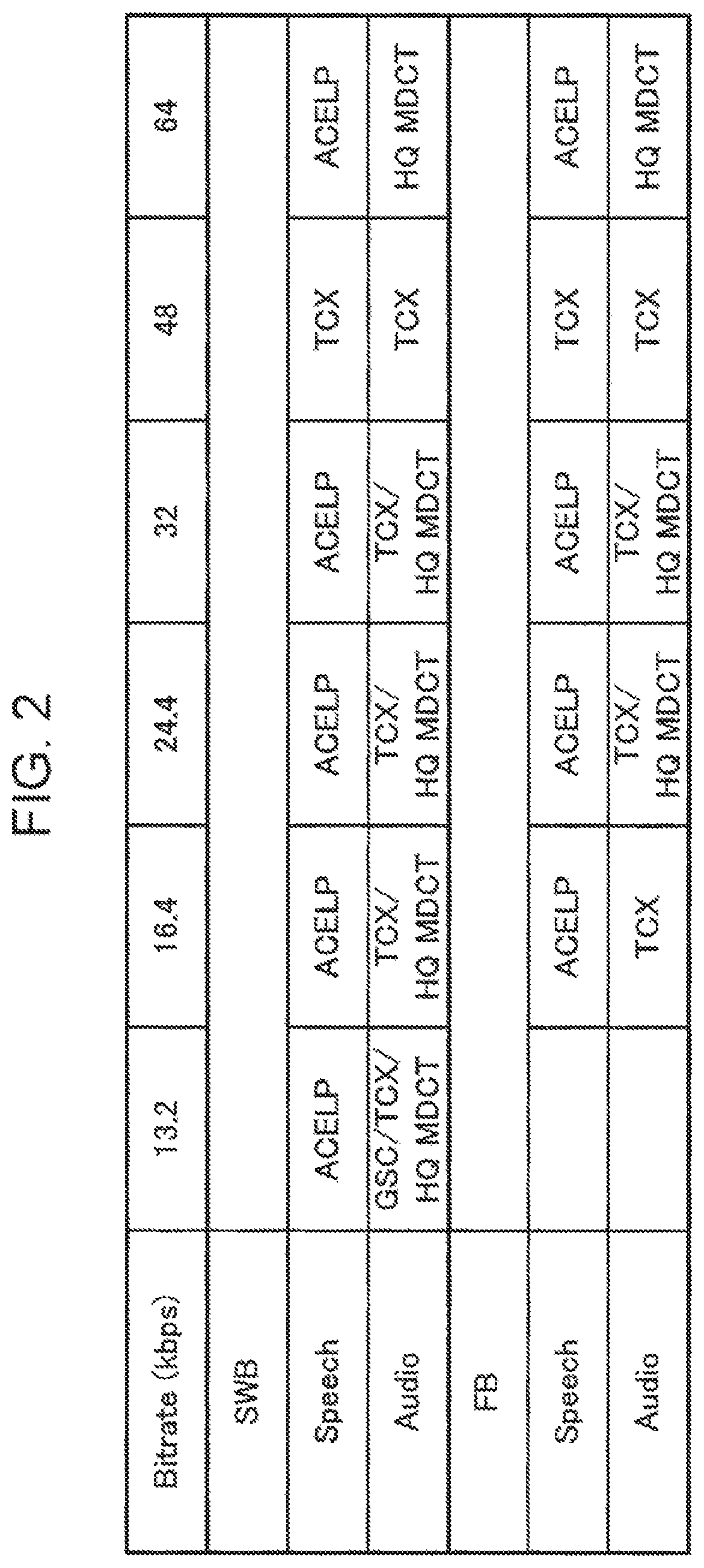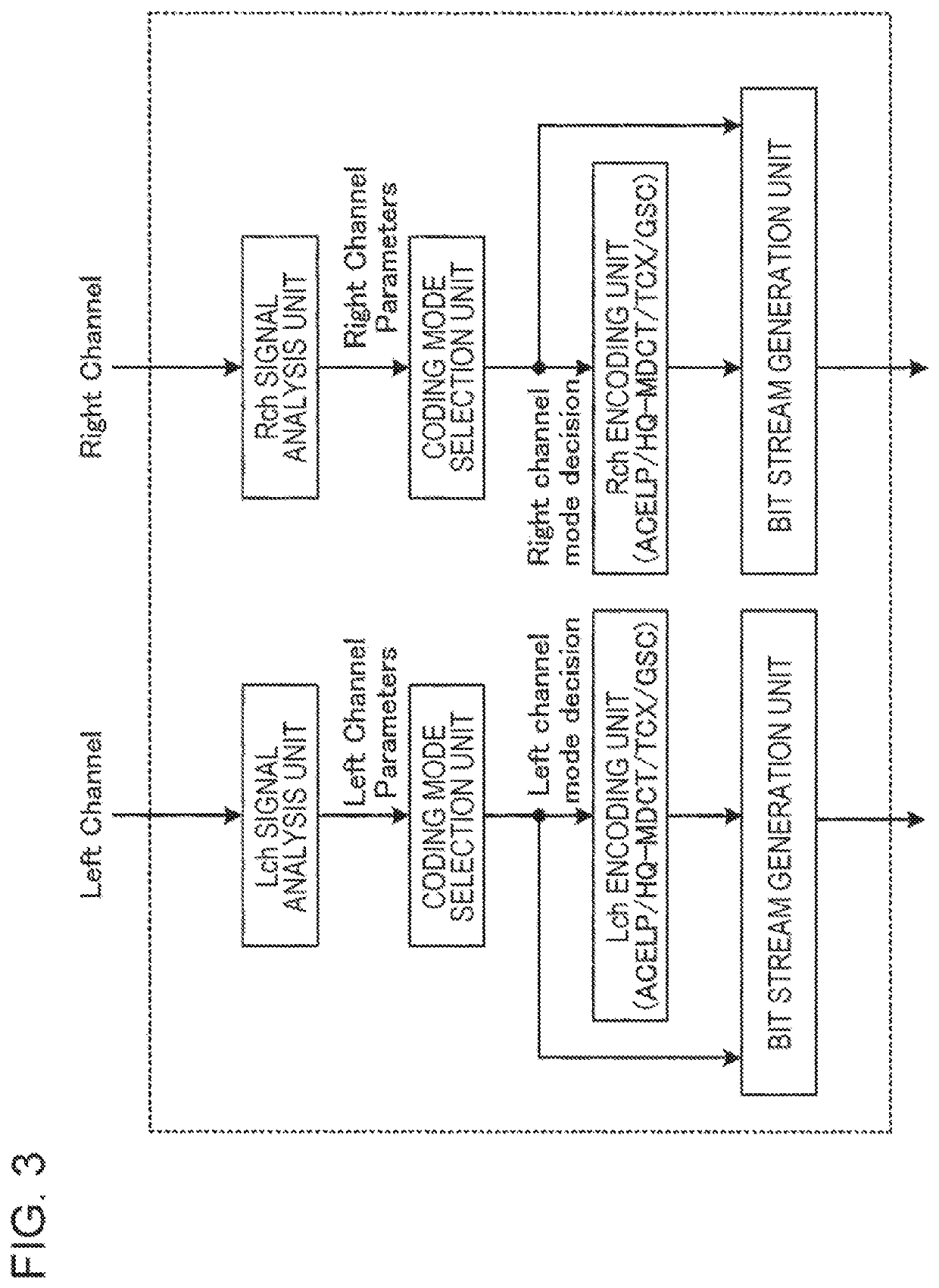Encoder and encoding method
a technology applied in the field of encoder and encoder, can solve the problems of deteriorating stereo reproduction sound quality, evs codec does not support input and output of stereo signals, etc., and achieve the effect of preventing deterioration of sound quality
- Summary
- Abstract
- Description
- Claims
- Application Information
AI Technical Summary
Benefits of technology
Problems solved by technology
Method used
Image
Examples
first embodiment
Modification 2 of First Embodiment
[0117]According to Modification 2, unlike Modification 1, the adaptive mixing unit 141 calculates the environmental sound component energy ratio AEND of the non-dominant channel for each of the sub-bands by using the correlation coefficient α in addition to PND, PXL, PXR for each of the sub-bands as follows:
[0118][Formula11]AEND(i)=A(i)PND(i)=PXL(i)+PXR(i)-(PXL(i)+PXR(i))2-4(1-α(i)2)PXL(i)PXR(i)2PND(i).(11)
[0119]Thereafter, like Modification 1, the adaptive mixing unit 141 can calculate the weighting coefficient for the analysis parameter of each of the dominant channel and the non-dominant channel by using equation (10) and equation (7).
[0120]That is, according to Modification 2, the adaptive mixing unit 141 obtains a weighting coefficient from the sum of energy ratios AEND calculated for all of the sub-bands. As a result, like Modification 1, the adaptive mixing unit 141 uses the channel signal energy (PND, PXL, PXR) obtained in...
second embodiment
[0122]If the determination result (the selection result) of the coding mode is frequently switched between frames, the subjective quality of the decoded signal may deteriorate. Therefore, according to the present embodiment, a method is described for preventing frequent switching of the coding mode determination result between frames.
[0123][Configuration of Encoder]
[0124]An encoder according to the present embodiment has the same basic configuration as the encoder 100 according to the first embodiment and, thus, is described with reference to FIG. 5. However, according to the present embodiment, the encoder 100 includes a DMA stereo encoding unit 150 illustrated in FIG. 9 instead of the DMA stereo encoding unit 104 illustrated in FIG. 5.
[0125]FIG. 9 is a block diagram illustrating a configuration example of the DMA stereo encoding unit 150 according to the present embodiment.
[0126]Note that the same reference numerals are used in FIG. 9 to describe those configurations that are iden...
third embodiment
[Configuration of Encoder]
[0143]FIG. 11 is a block diagram illustrating the configuration of an encoder 200 according to the present embodiment.
[0144]Note that the same reference numerals are used in FIG. 11 to describe those configurations that are identical to the configurations of the first embodiment (FIG. 5), and the description of the configurations are not repeated. More specifically, as compared with the configurations of the first embodiment (FIG. 5), the encoder 200 illustrated in FIG. 11 further includes a DM-M / S (Mid / Side) conversion unit 202 and an M / S stereo encoding unit 204.
[0145]In the encoder 200, an inter-channel correlation calculation unit 201 selects, from among DM stereo encoding, DMA stereo encoding, and added M / S stereo encoding, one of the stereo encoding modes on the basis of the calculated inter-channel correlation (the correlation coefficient α). The inter-channel correlation calculation unit 201 outputs a stereo mode decision flag indicating the selecti...
PUM
 Login to View More
Login to View More Abstract
Description
Claims
Application Information
 Login to View More
Login to View More - R&D
- Intellectual Property
- Life Sciences
- Materials
- Tech Scout
- Unparalleled Data Quality
- Higher Quality Content
- 60% Fewer Hallucinations
Browse by: Latest US Patents, China's latest patents, Technical Efficacy Thesaurus, Application Domain, Technology Topic, Popular Technical Reports.
© 2025 PatSnap. All rights reserved.Legal|Privacy policy|Modern Slavery Act Transparency Statement|Sitemap|About US| Contact US: help@patsnap.com



